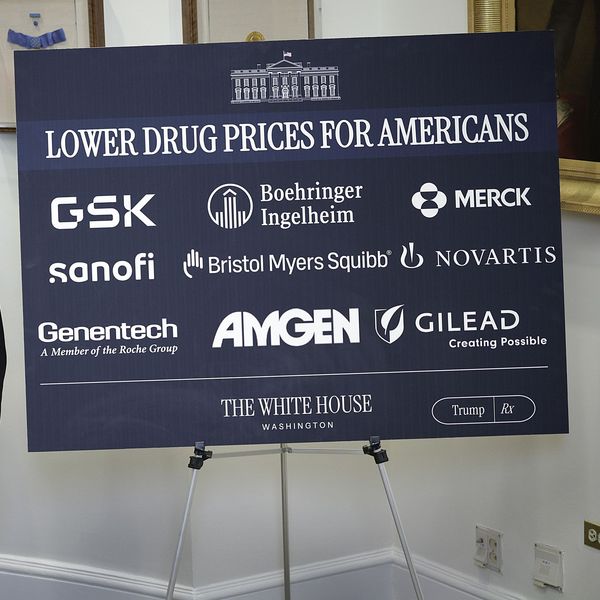
Diane Semo, whose daughter is in recovery from Heroin, joins over 100 drug reform advocates, former addicts, and family members who have lost loved ones to drugs in a march to demand action on Overdose Awareness Day on August 31, 2017 in New York City. (Photo: Spencer Platt/Getty Images)
Unsealed Database Reveals How Drug Companies Embarked on 'Reckless Pursuit of Profit' as Thousands Died From Opioid Epidemic
For the first time, a previously secret federal database of all opioid painkiller sales reveals what the pharmaceutical industry knew about the growing crisis
After a three year-long effort by journalists at the Washington Post and the Charleston Gazette-Mail in West Virginia, a federal judge on Monday finally lifted a protective order on a government database--which drug companies tried to keep hidden--that revealed how tens of billions of addictive opioid painkillers flooded communities nationwide in recent years.
As the Post reported Wednesday, the Drug Enforcement Administration's (DEA) Automation of Reports and Consolidated Order System (ARCOS) reveals that the country's largest pharmaceutical companies distributed 76 billion OxyContin and Vicodin pills between 2006 and 2012, with states including West Virginia and Kentucky saturated with enough painkillers for every resident to have hundreds of their own.
\u201cThis report of DEA data is bonkers. \n\nBetween 2006-2012, 76 BILLION opioids distributed, "enough pills to supply every adult & child in the country with 36 each year." \n\nIn RURAL areas? VA=306 per person, WV=203, KY=175.\n\nhttps://t.co/81sSX8vt7o\u201d— Jessica Lahey (@Jessica Lahey) 1563331240
The number of pills distributed annually rose 51 percent over seven years, with more than 12 billion dispensed in 2012. During this time, about 100,000 Americans died of prescription opioid overdoses.
As the Post reports, the database, which the DEA compiles based on sales data from drug companies, shows how "in case after case, the companies allowed the drugs to reach the streets of communities large and small, despite persistent red flags that those pills were being sold in apparent violation of federal law and diverted to the black market."
"The database reveals what each company knew about the number of pills it was shipping and dispensing and precisely when they were aware of those volumes, year by year, town by town," the Post reports.
Rep. Ro Khanna (D-Calif.) tweeted that the new information reveals how even as communities across the country were suffering, wealthy companies continued their "reckless pursuit of profit."
\u201cThese drug companies knew exactly how many opioid pills they were sending to each of the communities these drugs were ravaging. They didn't do anything about it. \n\nWhy?\n\nReckless pursuit of profit at the expense of the lives of millions.\nhttps://t.co/I0TTmXayzh\u201d— Rep. Ro Khanna (@Rep. Ro Khanna) 1563371078
The Post included in their report a map showing the areas where companies distributed the most opioid painkillers.
\u201cIf you'd like to see where the highest concentration of oxycodone and hydrocodone were shipped or who was shipping them, check out our interactive page with this information. https://t.co/ZFTJOSkx3z\u201d— Steven Rich (@Steven Rich) 1563323510
Between 2006 and 2012, the equivalent of about 66.5 pills per person poured into West Virginia, while about 63.3 pills per person were distributed in Kentucky. South Carolina, Nevada, and Tennessee also received copious amounts of the drugs.
The number of pills dispensed to the public over the time period in question far exceeds the data that was previously released in court filings and news reports.
ARCOS was kept secret until the Post released its report on Wednesday, despite multiple lawsuits against pharmaceutical companies which contributed to the opioid epidemic. The DEA and Department of Justice joined pharmaceutical giants in pushing for the database to be kept secret, arguing its release could compromise ongoing investigations into the causes of the epidemic.
U.S. District Judge Dan Polster lifted the protective order on ARCOS after the two newspapers' Freedom of Information Act request was denied by the DEA, and after an appeals court reversed Polster's earlier ruling against the publications. Polster is currently presiding over the largest civil action in U.S. history, with about 2,000 cities, towns, and counties suing pharmaceutical companies for their alleged contributions to the opioid crisis.
An Urgent Message From Our Co-Founder
Dear Common Dreams reader, The U.S. is on a fast track to authoritarianism like nothing I've ever seen. Meanwhile, corporate news outlets are utterly capitulating to Trump, twisting their coverage to avoid drawing his ire while lining up to stuff cash in his pockets. That's why I believe that Common Dreams is doing the best and most consequential reporting that we've ever done. Our small but mighty team is a progressive reporting powerhouse, covering the news every day that the corporate media never will. Our mission has always been simple: To inform. To inspire. And to ignite change for the common good. Now here's the key piece that I want all our readers to understand: None of this would be possible without your financial support. That's not just some fundraising cliche. It's the absolute and literal truth. We don't accept corporate advertising and never will. We don't have a paywall because we don't think people should be blocked from critical news based on their ability to pay. Everything we do is funded by the donations of readers like you. Will you donate now to help power the nonprofit, independent reporting of Common Dreams? Thank you for being a vital member of our community. Together, we can keep independent journalism alive when it’s needed most. - Craig Brown, Co-founder |
After a three year-long effort by journalists at the Washington Post and the Charleston Gazette-Mail in West Virginia, a federal judge on Monday finally lifted a protective order on a government database--which drug companies tried to keep hidden--that revealed how tens of billions of addictive opioid painkillers flooded communities nationwide in recent years.
As the Post reported Wednesday, the Drug Enforcement Administration's (DEA) Automation of Reports and Consolidated Order System (ARCOS) reveals that the country's largest pharmaceutical companies distributed 76 billion OxyContin and Vicodin pills between 2006 and 2012, with states including West Virginia and Kentucky saturated with enough painkillers for every resident to have hundreds of their own.
\u201cThis report of DEA data is bonkers. \n\nBetween 2006-2012, 76 BILLION opioids distributed, "enough pills to supply every adult & child in the country with 36 each year." \n\nIn RURAL areas? VA=306 per person, WV=203, KY=175.\n\nhttps://t.co/81sSX8vt7o\u201d— Jessica Lahey (@Jessica Lahey) 1563331240
The number of pills distributed annually rose 51 percent over seven years, with more than 12 billion dispensed in 2012. During this time, about 100,000 Americans died of prescription opioid overdoses.
As the Post reports, the database, which the DEA compiles based on sales data from drug companies, shows how "in case after case, the companies allowed the drugs to reach the streets of communities large and small, despite persistent red flags that those pills were being sold in apparent violation of federal law and diverted to the black market."
"The database reveals what each company knew about the number of pills it was shipping and dispensing and precisely when they were aware of those volumes, year by year, town by town," the Post reports.
Rep. Ro Khanna (D-Calif.) tweeted that the new information reveals how even as communities across the country were suffering, wealthy companies continued their "reckless pursuit of profit."
\u201cThese drug companies knew exactly how many opioid pills they were sending to each of the communities these drugs were ravaging. They didn't do anything about it. \n\nWhy?\n\nReckless pursuit of profit at the expense of the lives of millions.\nhttps://t.co/I0TTmXayzh\u201d— Rep. Ro Khanna (@Rep. Ro Khanna) 1563371078
The Post included in their report a map showing the areas where companies distributed the most opioid painkillers.
\u201cIf you'd like to see where the highest concentration of oxycodone and hydrocodone were shipped or who was shipping them, check out our interactive page with this information. https://t.co/ZFTJOSkx3z\u201d— Steven Rich (@Steven Rich) 1563323510
Between 2006 and 2012, the equivalent of about 66.5 pills per person poured into West Virginia, while about 63.3 pills per person were distributed in Kentucky. South Carolina, Nevada, and Tennessee also received copious amounts of the drugs.
The number of pills dispensed to the public over the time period in question far exceeds the data that was previously released in court filings and news reports.
ARCOS was kept secret until the Post released its report on Wednesday, despite multiple lawsuits against pharmaceutical companies which contributed to the opioid epidemic. The DEA and Department of Justice joined pharmaceutical giants in pushing for the database to be kept secret, arguing its release could compromise ongoing investigations into the causes of the epidemic.
U.S. District Judge Dan Polster lifted the protective order on ARCOS after the two newspapers' Freedom of Information Act request was denied by the DEA, and after an appeals court reversed Polster's earlier ruling against the publications. Polster is currently presiding over the largest civil action in U.S. history, with about 2,000 cities, towns, and counties suing pharmaceutical companies for their alleged contributions to the opioid crisis.
After a three year-long effort by journalists at the Washington Post and the Charleston Gazette-Mail in West Virginia, a federal judge on Monday finally lifted a protective order on a government database--which drug companies tried to keep hidden--that revealed how tens of billions of addictive opioid painkillers flooded communities nationwide in recent years.
As the Post reported Wednesday, the Drug Enforcement Administration's (DEA) Automation of Reports and Consolidated Order System (ARCOS) reveals that the country's largest pharmaceutical companies distributed 76 billion OxyContin and Vicodin pills between 2006 and 2012, with states including West Virginia and Kentucky saturated with enough painkillers for every resident to have hundreds of their own.
\u201cThis report of DEA data is bonkers. \n\nBetween 2006-2012, 76 BILLION opioids distributed, "enough pills to supply every adult & child in the country with 36 each year." \n\nIn RURAL areas? VA=306 per person, WV=203, KY=175.\n\nhttps://t.co/81sSX8vt7o\u201d— Jessica Lahey (@Jessica Lahey) 1563331240
The number of pills distributed annually rose 51 percent over seven years, with more than 12 billion dispensed in 2012. During this time, about 100,000 Americans died of prescription opioid overdoses.
As the Post reports, the database, which the DEA compiles based on sales data from drug companies, shows how "in case after case, the companies allowed the drugs to reach the streets of communities large and small, despite persistent red flags that those pills were being sold in apparent violation of federal law and diverted to the black market."
"The database reveals what each company knew about the number of pills it was shipping and dispensing and precisely when they were aware of those volumes, year by year, town by town," the Post reports.
Rep. Ro Khanna (D-Calif.) tweeted that the new information reveals how even as communities across the country were suffering, wealthy companies continued their "reckless pursuit of profit."
\u201cThese drug companies knew exactly how many opioid pills they were sending to each of the communities these drugs were ravaging. They didn't do anything about it. \n\nWhy?\n\nReckless pursuit of profit at the expense of the lives of millions.\nhttps://t.co/I0TTmXayzh\u201d— Rep. Ro Khanna (@Rep. Ro Khanna) 1563371078
The Post included in their report a map showing the areas where companies distributed the most opioid painkillers.
\u201cIf you'd like to see where the highest concentration of oxycodone and hydrocodone were shipped or who was shipping them, check out our interactive page with this information. https://t.co/ZFTJOSkx3z\u201d— Steven Rich (@Steven Rich) 1563323510
Between 2006 and 2012, the equivalent of about 66.5 pills per person poured into West Virginia, while about 63.3 pills per person were distributed in Kentucky. South Carolina, Nevada, and Tennessee also received copious amounts of the drugs.
The number of pills dispensed to the public over the time period in question far exceeds the data that was previously released in court filings and news reports.
ARCOS was kept secret until the Post released its report on Wednesday, despite multiple lawsuits against pharmaceutical companies which contributed to the opioid epidemic. The DEA and Department of Justice joined pharmaceutical giants in pushing for the database to be kept secret, arguing its release could compromise ongoing investigations into the causes of the epidemic.
U.S. District Judge Dan Polster lifted the protective order on ARCOS after the two newspapers' Freedom of Information Act request was denied by the DEA, and after an appeals court reversed Polster's earlier ruling against the publications. Polster is currently presiding over the largest civil action in U.S. history, with about 2,000 cities, towns, and counties suing pharmaceutical companies for their alleged contributions to the opioid crisis.

